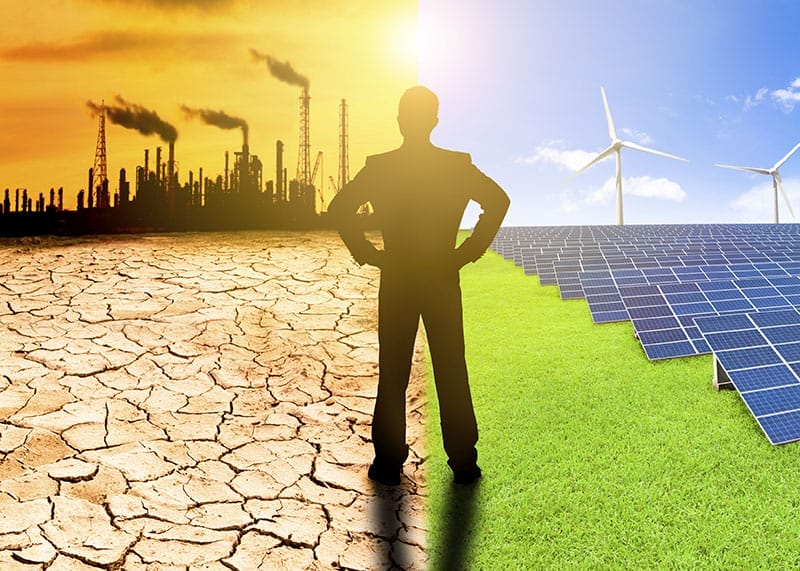The Paris COP21 Climate Agreement in December put the world in an exciting position, with 187 countries agreeing to make intended nationally determined contributions (INDCs) to control the impacts of CO2 on our environment. That we reached such a consensus was amazing in itself, but now we need to act on this collective momentum. Many wonder who will lead this charge and where the “big wins” will come from. Those who follow these issues can now celebrate, as 2016 brought a large unexpected global gift—oil at $30 per barrel, or even less (it went below $27 today).
No one ever expected these low prices. With assumptions of “peak oil” constraining supply and China and India’s growth driving demand, most assumed high revenues and continual investment while government subsidies kept the machine well-oiled. The old school of thought was that high oil prices made renewable energy more competitive, but this did not remove the need for clean energy to also compete against over $650 billion in global subsidies to the oil industry.
Now, contrary to popular belief, with oil at $30 per barrel and the reverse oil shock, we have the opportunity of a lifetime to shift needed investment into clean energy. Why is this the case? Because Big Oil companies are hemorrhaging at the wells and laying off large chunks of their staff, and countries are now much less inclined to keep those unnatural levels of pollution subsidies intact as they reallocate spending on infrastructure and services that have long been needed. With low oil prices, the social pressure to keep prices artificially low is also greatly reduced.
Listening to the Starting Gun
Those listening will have heard the “starting gun” go off, marking the start of the big shift to renewables that we have been waiting for. Large oil players no longer have the resources or the guts to make new big investments in wells, which are increasingly more expensive. The oil industry is down over $3 trillion since prices have fallen, with earnings of the S&P 500 energy sector down by 76 percent. Of the U.S. syndicated loans for the oil and gas industry ($256 billion), 15 percent are now regarded as distressed.
The other significant factor driving this shift is that changes now happen in Internet time, and the disruptive innovation of fracking will virtually guarantee that oil prices will not rise for a long time coming (unless there are significant international political disruptions, which is all the more likely with oil countries losing their main revenue sources). Fracking is the ability to extract gas from shale in previously unreachable locations and quantities with relative ease. This means that the large incumbents and oil nations who have relied on high prices have had the rug pulled out from under their feet with a multitude of smaller players now competing with production and supply.
Seeing the Environmental Silver Lining
Environmental groups do not like the potential dangers and impacts of fracking, but there is a big unintended silver lining for renewable energies. Now with low oil prices, even the new small fracking players will not want to enter the market. So, where will the money go? To clean energy. There is no turning back technology, and fracking has now opened the flood gate, creating enough supply that the U.S. can become an oil/gas exporter.
That flood gate also comes in parallel with scaled advances in solar, wind and other clean technologies, bringing prices down even further, while uptake and installations escalate. This is coupled with:
- Rapid growth of electric vehicles and battery capacity with the likes of Tesla and Panasonic
- Boom of megacities where autos will no longer thrive
- Regional trade agreements, like the one within the Asia Pacific Economic Cooperation (APEC), which reduces the tariffs on clean-tech equipment to 5 percent or less between all member states, while they collectively aim to double renewable energy generation by 2020 and reduce energy intensity 45 percent by 2035.
Tapping the Smart Money
Smart money will now begin to shift to the places it belongs—in smart, long-term investments for clean energy. Countries will now be even more supportive than before for clean energy options, as a consequence of the Paris COP21 Agreement and the INDCs, while the Sustainable Development Goals (SDGs) are being more widely addressed, having been revised by the United Nations in September. These new investments are “smart” because they also come with reduced liabilities, which face old energy in the form carbon taxes or offset fees, pension fund divestment pressure and poor brand reputation from the carbon-centric world of the past.
Long-term investors and lenders now really have to take an educated guess at 30-year infrastructure bets on oil, and even coal, both with significant new uncertainties. Short-term money, on the other hand, will steer clear for the immediate future, giving room for even more momentum for renewables to take hold. Investments in environmental goods and services, meanwhile, are expected to grow from $500 billion today to $2 trillion within five years.
Conclusion: Renewables Can and Will Take off
The perfect storm is here, but it has come in the back door and has caught everyone by surprise. In fact, most have not seen it yet. The mindset continues to be that low oil prices will kill off new innovations. Not this time. It only takes a year or two in this day and age for innovations and scale to take root, and with all of the right factors now in place, this is the time for renewables to take off. I hope you are ready to come along for the ride.

























